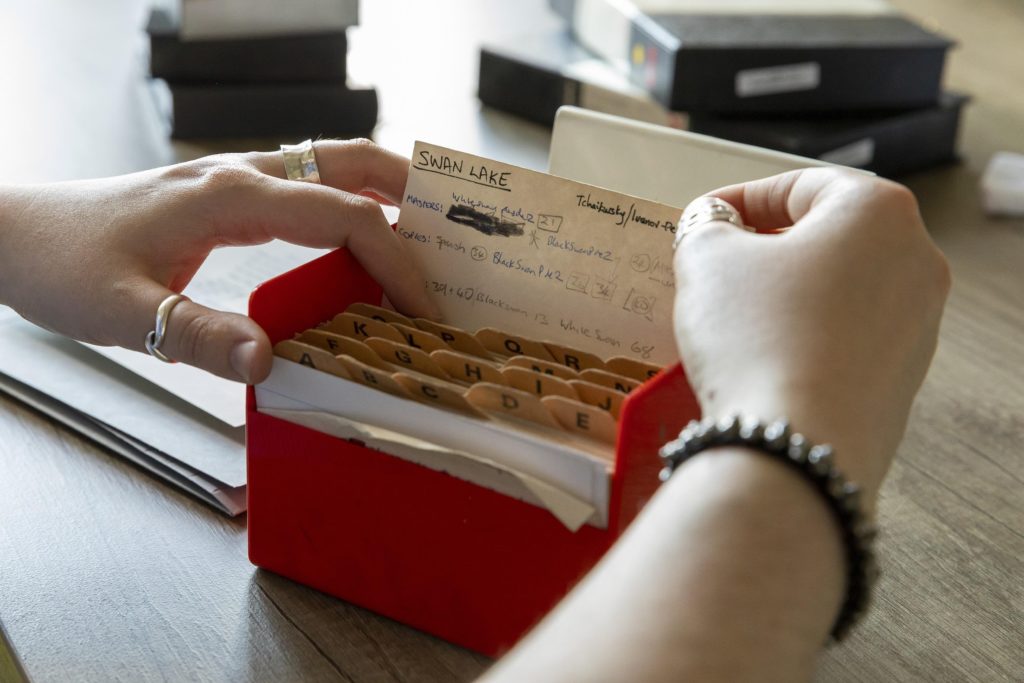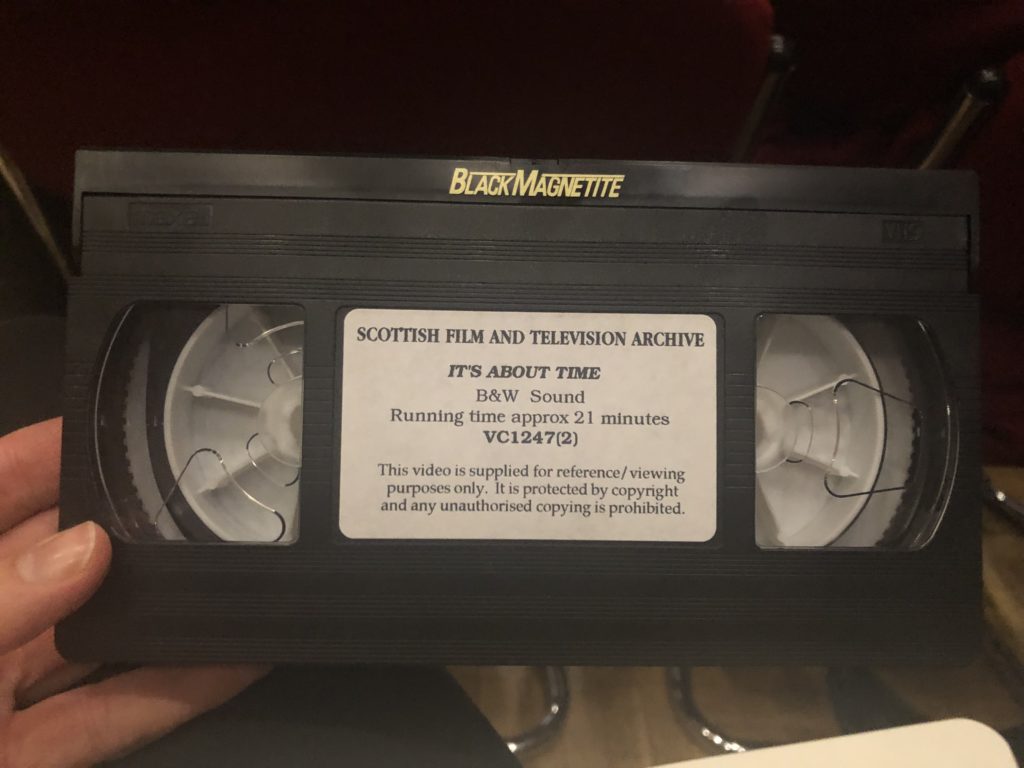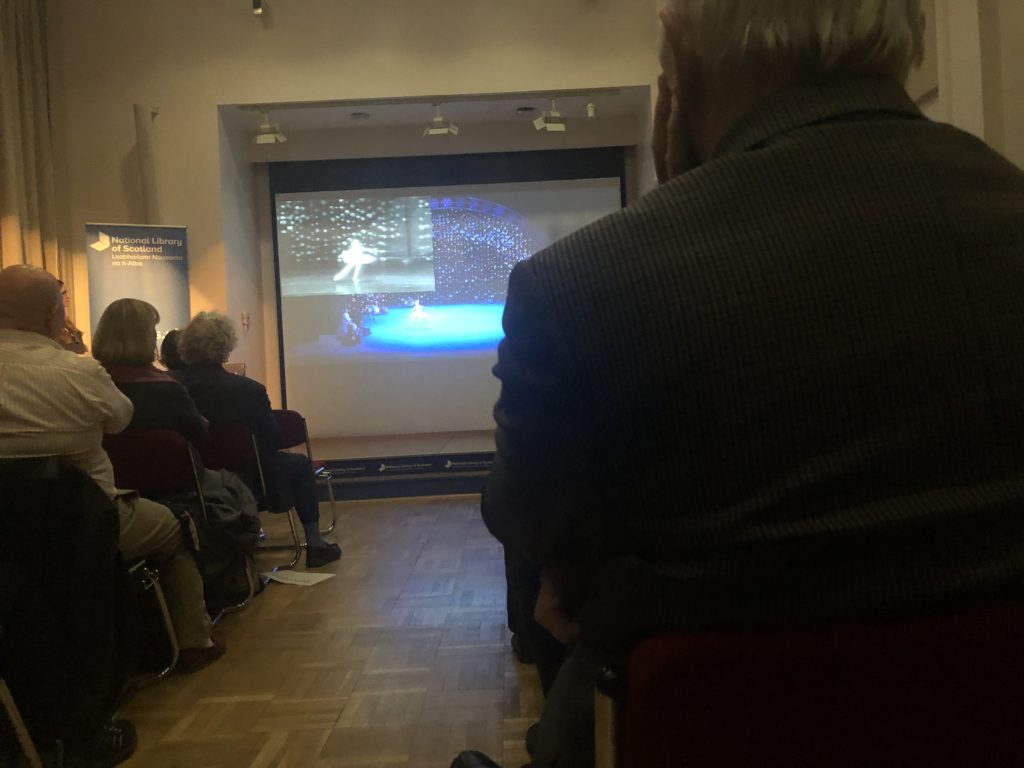
c. National Library of Scotland (2019)
On 4th October I attended NLS “Sharing 50 Years of Scottish Ballet” event, a behind the scenes look into the current collaborative project between Scottish Ballet and NLS Moving Image Archive to digitise 46,000 existing moving image formats from the company’s collection. The talk incorporated expert speakers from both institutions and focused on the urgency of digitising video tapes in particular, (their complete obsolescence and degradation predicted by 2028), as well as the significance of this project in terms of posterity – it will provide worldwide data, be permanently part of the library collection and as such will greatly contribute to the Scottish culture landscape.
Through having a public event on the nature of this partnership, NLS has taken a first step to show the positives of digitisation, (as well as providing a backstage look into the function and contribution of MIA), and the presentation itself had an effective sensory approach.

Videotapes were passed around to show original formats and aid in the understanding of the process of digitisation c. The Author (2019)

The presentation included digitised videos edited to provide side by side comparison of the same choreography at different moments in history c. The Author (2019)
There are obvious correlations between our project ‘Behind Glass’ and this digitisation partnership. Specifically, it can serve to address the two problems posed in our project:
- How can the National Library of Scotland engage audiences with our digital holdings through curated displays and public events?
- Is authenticity of the original format important?
We can look at Scottish Ballet Company and it’s public engagement programmes as inspiration in this regard. Notably, ‘Digital Season’, a month long eclectic programme of born digital content produced by interdisciplinary creatives from both within the company and on commission, ‘The Digital Season features short films, live streams and digital experiments to enhance, alter and inform the way we experience dance’, (Scottish Ballet, 2019). The new possibilities offered through digital technology and the partnerships and resources needed to sustain them can be further understood through reviewing specific works.
Tremble is SB’s grandest short film commission to date, staring twenty six SB dancers, set to Anna Meredith’s evocative ‘Nautilus’ track and co-choreographed and directed by Jessica Wright and Morgann Runacre-Temple, who use post-production techniques to play with time/dance effects, as well as surrealist imagery and humour to provide accessibility to new audiences. It becomes not only a public engagement exercise but an art film in its own right screened at international film festivals.
Frontiers is directed by in-house filmmaker Eve McConnachie, choreographed by San Francisco Ballet dancer Myles Thatcher and set to Edinburgh based Callum Easter’s ‘Make a Move’. It incorporates gender neutral choreography by six SB dancers to explore the problematic gender norms associated with the classical ballet industry and uses post-editing techniques to achieve a sense of fluidity between the pairs of dancers. Set in various industrial locations in Glasgow, the short film takes the company back to its roots and provides an element of realism, in this way the setting is just as important as the dance.
Prometheus & Epimetheus is a collaboration of Zachary Eastwood-Bloom (SB’s first Digital Artist in residence) and choreographer Alexander Whitley, featuring music by Ash Koosha and a cast of two SB dancers. Part of a series of three works titled Technology//Mythology//Allegory, the short film investigates our relationship to the progression of technology, using motion capture and digital augmentation to create structural digital visuals that connect and elevate the dance (even sparking a poetry commission titled Facets of a Quest Narrative).
These short films from Digital Season are a significant example of how a national institution more often than not considered inherently traditional to the public (mirroring NLS) is using the format progressively and to perform to a contemporary digital market without loosing its origins and marketability as a tactile experience – the digital products are artworks in themselves, using technology to visualise dance but not attempting to replace a live performance either. Further, the fact that these performances are designed for smartphones and cinema provide an accessibility to ballet not previously possible before. This accessibility via digital engagement effectively opens the door to potential new audiences, offering a solution to Brook, et al.’s (2018, p.31) recent cultural policy report that highlights contemporary dance and classical ballet as being only ‘minority pastimes’ (ibid).
A wealth of research has and is currently being undertaken exploring digital and mobile approaches to understanding visitor engagement with art and how this can help to break down institutional barriers. Ross et al. (2019, p. 399) suggests, ‘devices and mobile approaches make new arrangements between cultural heritage, movement, and public and private spaces’ and Souza e Silva (2006, p. 261) also explores the ‘space’ new mobile technologies offer, classifying them as ‘hybrid spaces’ (ibid), i.e. social spaces online that a user can connect and become part of whilst physically moving through an urban space. Bal (2006, p. 525) states, ‘the museum – as institution, material object, and endeavor – interferes with, makes “noise,” in other words causes interferences that trouble the “pure” aesthetic experience of visitors’, implying that the institutional space can hinder rather than enlighten and offers a resolution of filming conversations on artwork, carefully planned, yet in a separate setting to the institutional space, experimenting with video to record and exhibit how people might engage with art.
Studies such as these support the creation of an alternate digital space that retains a connection to the institution’s physical space. In the case of SB, their Digital Season videos provide access to an experience usually reserved for regular theatre going customers or audiences with pre-existing connections to the classical ballet industry. Through not just recording a performance, but rather creating a new type in a separate space, SB is able to reach a wider audience, perhaps one that has never been able to connect with ballet previously, to give an idea of their institution’s core values. With this in mind and in the way Scottish Ballet fully integrates ‘digital’ as part of their body of programming now, are we able with our project to start a platform to do the same with NLS born digital?
Bal, M. (2006) ‘Exposing the Public’, in Macdonald, S. (ed.) A Companion to Museum Studies, Oxford: Blackwell Publishing Ltd, pp. 525–42. DOI: 10.1002/9780470996836.ch32
Brook, O., O’Brien, D. and Taylor, M. (2018) Panic! Social Class, Taste and Inequalities in the Creative Industries Available at: http://createlondon.org/wp-content/uploads/2018/04/Panic-Social-Class-Taste-and-Inequalities-in-the-Creative-Industries1.pdf (Accessed: 16 November 2019).
Haldrup, M. and Bœrenholdt, J. O. (2015) ‘Heritage as Performance’, in Waterton, E. and Watson, S. (eds.) The Palgrave Handbook of Contemporary Heritage Research, London: Palgrave Macmillan, pp. 52–68. DOI: https://doi.org/10.1057/9781137293565_4.
Jess and Morgs (2019) About Available at: https://www.jessandmorgs.com/about (Accessed: 16 November 2019).
McConnachie, E. (2019) Eve McConnachie: ‘Dance films can add something to the movement because you can isolate moments and play with time’ Interviewer: Apter, K. Available at: https://www.list.co.uk/article/108535-eve-mcconnachie-dance-films-can-add-something-to-the-movement-because-you-can-isolate-moments-and-play-with-time/ Accessed: 24 October 2019).
Miles, A. and Gibson, L. (2016) ‘Everyday participation and cultural value’, Cultural Trends, 25(3), pp. 151-157, DOI: 10.1080/09548963.2016.1204043.
National Library of Scotland (2019) Sharing 50 Years of Scottish Ballet’s History Available at: https://www.eventbrite.co.uk/e/sharing-50-years-of-scottish-ballets-history-tickets-67746129497 (Accessed: 24 October 2019).
Ross, J., Knox. J., Sowton, C. and Speed, C., (2019) ‘Mobilising connections with art: Artcasting and the digital articulation of visitor engagement with cultural heritage’, International Journal of Heritage Studies, 25(4), pp. 395–414. DOI: 10.1080/13527258.2018.1493698
Scottish Ballet (2019) Digital Season 2019 Available at: https://www.scottishballet.co.uk/event/digital-season-19 (Accessed: 24 October 2019).
Scottish Ballet (2019) Frontiers Available at: https://www.scottishballet.co.uk/tv/frontiers (Accessed 16 November 2019).
Scottish Ballet (2019) Prometheus & Epimetheus Available at: https://www.scottishballet.co.uk/tv/prometheus-and-epimetheus (Accessed: 16 November 2019).
Scottish Ballet (2019) Tremble Available at: https://www.scottishballet.co.uk/tv/tremble (Accessed 16 November 2019).
Souza e Silva, A de. (2006) ‘From Cyber to Hybrid Mobile Technologies as Interfaces of Hybrid Spaces’, Space and Culture, 9(3), pp. 261–78. DOI: https://doi.org/10.1177/1206331206289022.
The Fruitmarket Gallery (2019) Scottish Ballet Digital Season at The Fruitmarket Gallery Available at: https://www.fruitmarket.co.uk/event/scottish-ballet-digital-season-at-the-fruitmarket-gallery/ (Accessed: 24 October 2019).

Comments
A really great start, Amy. Lots to build on for the final submission. You’re really making the most of the blog format too by embedding links and video.
The case study is well chosen and I like the way that you begin with the existing connections between NLS and Scottish Ballet. You centre the new possibilities offered through digital technologies for institutions willing to embrace it. Perhaps you can go into more detail on what these are for the final submission and the infrastructures needed to exploit them (such as partnerships and resources). The next step is to bring in the literature on digital engagement to help you to analyse these developments.